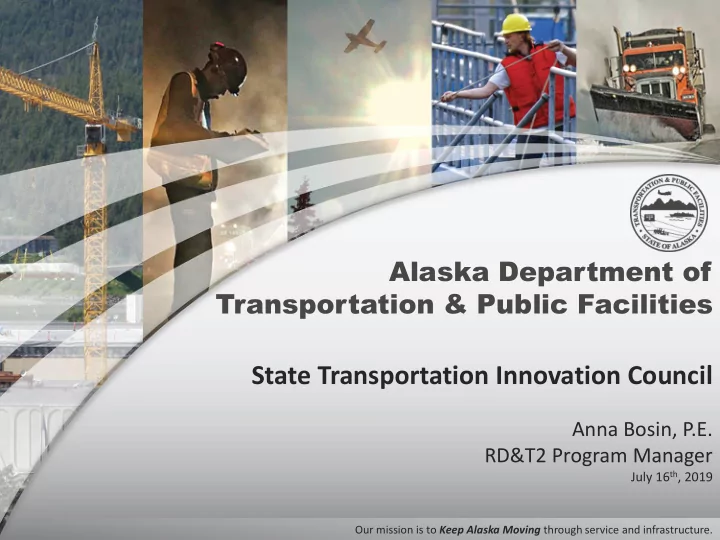

Alaska Department of Transportation & Public Facilities State Transportation Innovation Council Anna Bosin, P.E. RD&T2 Program Manager July 16 th , 2019 Our mission is to Keep Alaska Moving through service and infrastructure.
STIC in Alaska STIC Co-Chairs: John MacKinnon- Alaska DOT&PF Commissioner Sandra Garcia-Aline - FHWA Division Administrator https://www.fhwa.dot.gov/innovation/stic/ 7/12/2019 2
RD&T2 Linked Resource 3
STIC Charter MISSION : Facilitate the rapid implementation of technology, tactics and techniques among transportation program delivery professionals starting at Alaska DOT&PF and moving toward all levels of tribal and local government and throughout the private and non-profit sector to ensure smart, efficient investment in Alaska's transportation services and infrastructure. The Alaska STIC Charter summarized in three bullets: • Provide a forum for discussing and proposing solutions to transportation- related problems. • Select technologies , tactics and techniques on which to focus implementation efforts. • Share information with stakeholders through meetings, workshops, reporting and conferences. 4
STIC Membership and Meetings 5
FHWA STIC Guidance • Technology & Innovation Deployment Program (TIDP) Goals • Requirements for eligibility • Examples of allowable activities 6
Outreach and Notification Plan Public notification of grant: - AK DOT&PF website State Transportation Innovation Council (STIC) - Includes selection process in notification - Applications due in springtime annually Outreach plan: - DOT’s Research & Training list -serve - LTAP local government contacts - STIC member agencies and contacts - Tribal agencies - FHWA 7
Project Selection Process 1. Applications first screened by staff for accuracy and eligibility prior to STIC consideration. 2. All Proposed projects must have a STIC member as champion. If the first two criteria met, then considered by STIC using following discussion points: • Does your project improve a safety concern or stimulate economic growth? • Does your project support cost savings or efficiency project delivery? • Does your project have a high likelihood to improve the way we do business or foster a culture of innovation? • Is your impact narrow or widespread (Statewide)? • Does the proposal include match funds beyond the 20% requirement? STIC votes – selection by majority (excluding FHWA) 8
STIC Projects Past and Present • 2016 - NEPA Training (Ben White – STWD DOT) • 2017 - Acceptance of Asphalt Paving Compaction (Rich Giessel – CR DOT Construction) • 2018 - Development of a Manual for Implementation of an Alaska Utility Information Management System (Rex Young - NR DOT) • 2019 - Creation and Implementation of a Comprehensive, Statewide, Multi-division Augmented and Virtual Reality Program (Paul Eckman - NR DOT) 9
2016 – NEPA Training Developed training modules and associated materials to provide staff training on the Environmental Procedures Manual for the NEPA Assignment Program. Chapter 1. Environmental Procedures Overview Chapter 2. Class of Action Determination Chapter 3. Categorical Exclusion Chapter 4. Environmental Assessment and Finding of No Significant Impact Chapter 5. Environmental Impact Statement Chapter 6. Re-evaluation Chapter 7. Public and Agency Involvement Chapter 8. Section 4(f) and Section 6(f) Chapter 9. Endangered Species Act and Marine Mammal Protection Act Chapter 10. Cultural Resources 10
2016 – NEPA Training The NEPA training modules can be accessed from the Statewide Environmental Office training website via a link to the introductory webpage: • http://www.dot.state.ak.us/stwddes/desenviron/resources /final/website/index.html 11
2017 - Acceptance of Asphalt Paving Compaction • Tested draft performance specification for acceptance of asphalt paving compaction based on full-coverage density data collected by ground-penetrating radar (GPR). • GPR equipment measures and maps compaction of freshly placed asphalt right behind the paving equipment. That means defects can be identified and fixed during the paving process. 12
2017- Acceptance of Asphalt Paving Compaction The GPR technology was demonstrated at a June meeting of the Alaska STIC, providing attendees with hands-on experience using the equipment. Deployment of a continuous full-coverage compaction specification for asphalt paving to enhance project quality and pavement life. 13
2018- Development of a Manual for Implementation of an Alaska Utility Information Management System • • Visualization tool • Enterprise-wide access to utility data • Establish data standards • Implement in all 3 DOT regions 14
2019 - Creation and Implementation of a Comprehensive, Statewide, Multi-division Augmented and Virtual Reality Program Purchase hardware necessary to implement a virtual reality (VR) and augmented reality, that includes training. What are the benefits? • Help design engineers identify inconsistencies, errors, and omissions in design sets and interact with a 3D model in the real world at the site of construction . This will reduce design errors and cost of change orders in construction. • Improve comprehensive design reviews to take place away from the project site. This will reduce travel costs and potentially make it possible for more experts to review plan sets and provide valuable insight prior to and during construction. 15
2019 - Creation and Implementation of a Comprehensive, Statewide, Multi-division Augmented and Virtual Reality Program • Allow the public to view design alternatives through VR/AR to better understand our plans and provide more comprehensive and meaningful feedback. • Assist with the training of new engineers to better identify mistakes. Some design mistakes are difficult to identify in a 2D model, but easy to identify in a 3D model, which ultimately reduces time and cost. 16
How Do You Submit a Project for Consideration? The 2020 STIC incentive grant should be available by early February. The application deadline is usually around the middle of April. See the STIC link on the Research & T2 website: State Transportation Innovation Council (STIC) Contacts for STIC questions: • Dave Waldo at Research & T2 451-5323 david.waldo@alaska.gov • Anna Bosin at Research Development & T2 269-6208 anna.bosin@alaska.gov 17
FHWA Innovator https://www.fhwa.dot.gov/innovation/innovator/ 18
FHWA Every Day Counts https://www.fhwa.dot.gov/innovation/everydaycounts/about-edc.cfm 19
Recommend
More recommend